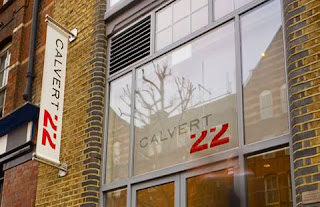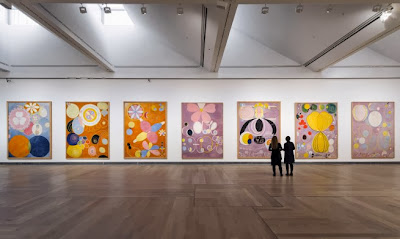I went with my Uni group & tutor to visit the Whitechapel Gallery. The Whitechapel Gallery is been through extensive refurbishment completed recently (a two year programme of work done) to include the former Passmore Edwards library building next door, vacated when the Idea Whitechapel Store opened. This had given much more space to the Gallery turning it into an Education centre.
We where there specifically to view the exhibition of British Artist Sarah Lucas (YBA). All her famous works, most recent works and her famous sculptures made out of tights, giant posters with flying penis tips are in the exhibition. I wish I had brought a camera not to take pictures of her work as it wasn't allowed but to take pictures of the shocked faces of my fellow students. Some students where saying: I thought I had seen it all I can't believe what I am seeing: flying penis tips?! Yes and I replied: Did you a have a look at the plucked fresh chicken there? Or at the kipper in a see through plastic bag?
They looked at me horrified and replied back: not yet, I am not sure...So I said: go on they are just over there. In Bitch she reduces the female body in a melon and kipper which I found really funny photo above.
I did ask the gallery attendant if it was a real chicken and they said yes. So I asked them; does it mean that you change the chicken on a daily basis? They replied yes and we also change the fried eggs over there. I didn't want to get into it any further but I was nearly going to ask them if they actually fry the eggs in the morning before putting them in the gallery for viewing or did they buy them every morning near by? Also I wonder what they did with the fresh chicken, eggs and kipper do they just throw it away or eat it every evening?
Sarah Lucas was part of the famous YBA's ( Damien Hirst,, Gary Hume, Angus Fairhurst) and was in the famous Freeze exhibition in 1988.


She challenges basically stereotypical representations of sexuality and gender, the relationship between them, social identity and she questions the darker side of ourselves, our self destruction using as her tools every day objects, ready mades, images. She uses collages, installations, sculptures, food, old furniture combined with assemblage techniques. In the gallery are shown the famous pictures of her self in particular male & sexual poses: legs wide open, wearing leather jackets, sun glasses or sacking a banana staring defiant, confrontational towards the viewer most times holding a cigarette as a weapon of defiance, independence, masculinity. She forces the viewer to look under the surface of things by using masculine posture of behaviour in her photographs undermining the stereotypical view of masculinity shown in the media in an ironic, grotesque full on way there is no escaping the images.

As the photos are not small but they are very big/large and in your face which reminded me of glamorous photos taken of famous people for display but she is making fun of this at the same time I didn't feel one could gain any pleasure by looking at her like men do when viewing naked bodies of women as she looks distinctively unglamourous she frustrates any attempt of voyeurism on the viewer's part. Also the repetition of portraits made me think of another artist Martin Kippenberger and kind of tragic view of human beings, of the self.
Then there are the double paper spreads from newspapers such as the Sun with pics of overly sexualized female bodies male misogyny is given prime voice to make it weak.
Also I noticed several toilet bowls in the gallery which where direct references to Duchamp's Fountain so she uses repetition in her work to make a point they become self-referring.


I mean there is so much in the Gallery from the sculptures made out of tights, wire & wadding to two fries & kebabs (1992) where she placed meat in place of genitalia and yolks for nipples, photo above. The art work it's crude & funny at the same time by reducing symbols of naked female bodies she is making fun of men treating women like a quick take away.
Au Naturel (1994) an old mattress where on top we see a cucumber ( melon, cucumbers possibly repressed sexual desires) and two oranges representing a phallus ( did I say that this exhibition is not suitable for kids) representing masculinity on the other side two melons & a bucket which represent femininity which reminds you of maybe a one night stand in a cheap bed sit, the sex in her work is not enjoyable is not supposed to make you fantasies but think, it s has a defiant punk edge to it which is very freeing.
The Upstairs gallery was covered in Wall Paper 1993/2013 (see photo below) of again male genitalia surrounded by opened bear cans and what appear to be a piece of car wreck again is sexual images ain't pleasurable but they give you strong sense of aversion.
One thing that I felt is that the space was to small for all the items on display I think they should have chosen maybe less items to put on display or the work needs a bigger room, more space between each art work it felt claustrophobic at times.
Fuck destiny 2000, which shows an abstract scene of sexual intercourse below.
The last rooms comped of bronze sculptures Dacre (2013) abstract androgynous cold nude sex is there but less in your face, more part of the old establishment less the punk angst
I prefer the row sculptures made out of tights and wire which reminded me of bodily functions the body both masculine & feminine as wadding & tights are used by women so are soft while wire it's cold and hard.

There was a lot going on in this exhibition so you need to stick through the strong art work, images also I advise viewers to be aware of Freud's studies on fetishism, where objects appear in dreams this due to sexual frustration sexual repression & be aware of Surrealism as they study the 'other' as the normal one, to explore the dark side of modernity when looking at Sarah Lucas work but is not necessary. I did find that her work made me think also about what is art and what isn't and what turns an object into art?





























































